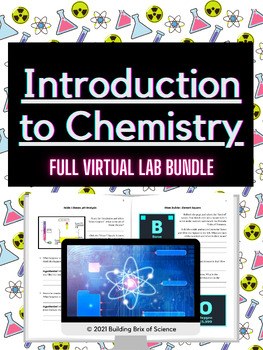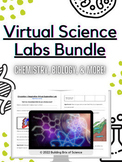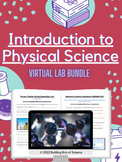Introduction to Chemistry Full PhET Virtual Lab Bundle
- Zip
- Internet Activities
What educators are saying
Products in this Bundle (11)
showing 1-5 of 11 products
Also included in
- Save 30% on my store's entire virtual lab collection with this Science Virtual Exploration Labs Activity Bundle! These Virtual Labs cover a wide range of topics, including Chemistry, Astronomy, Genetics, and more! If you would like to try a free sample, please download Into the Bloodstream from my sPrice $157.50Original Price $225.00Save $67.50
- Get over 30% off each assignment with the Introduction to Physical Science Virtual Lab Bundle! These Virtual Labs cover a wide range of topics, including Matter, Chemical Reactions, and Physics! Included in this Virtual Lab Bundle are:ChemistryBuild an AtomThe Periodic TableIsotopes & Atomic MasPrice $44.00Original Price $63.00Save $19.00
Description
Get over 30% off each lab with the Introduction to Chemistry Virtual Lab Bundle! These eleven virtual labs introduce students to the Basics of Chemistry and teaches them about Atoms and Molecules, The Periodic Table, States of Matter, Solutions, Acids & Bases, and Chemical Equations. This bundle includes:
Virtual Exploration Labs
Check out the Interactive Simulations below:
Reactants, Products, & Leftovers
Purchase includes ELEVEN 3 to 4-page Student Worksheets (PDF), six 3 to 4-page Teacher Answer Keys (PDF), and six 3 to 4-page Digital Student Worksheets (Google Slides).
VIRTUAL LEARNING
This lab comes with a Google Slides version of the Student Worksheet hyperlinked in the Teacher Answer Key - this lab is designed for digital and face-to-face learning!
❗Permission is granted to copy pages specifically for student or teacher use only by the original purchaser or licensee. The reproduction of this product for any other use is strictly prohibited. Copying this product in any part and placing it on the Internet (even on a personal website) is strictly prohibited and a violation of the Digital Millennium Copyright Act (DCMA).
_________________________________________________________________
⭐ BE THE FIRST TO LEARN ABOUT NEW SCIENCE RESOURCES! ⭐
Hit the Green Star at the top of the page to follow my store! This will allow you to receive notifications whenever I update current resources and add brand new items.





